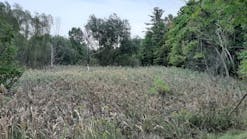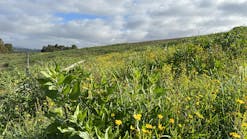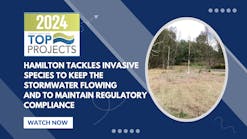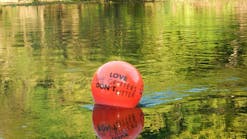Seasonal Considerations in the Use of Natives in Revegetation and Erosion Control Projects
Winter means different things to different people, and it certainly means different things to different revegetation and erosion control projects too. You might have completed your fall planting just in time and are now sitting back and gazing at the snow blanketing your project, anticipating the first green shoots to emerge come next spring. On the other hand, you may have missed the planting window for fall, in which case you’re mulling over when and what to plant when spring presents you with your next opportunity. You might even live and work in a region where late-autumn or winter planting is possible—even desirable—in which case you’re probably still out there getting that seed in place.
When using natives for revegetation and erosion control projects, one of the obstacles that still presents itself is availability of plant materials. While the number of native plants being grown for seed harvesting and propagation is increasing at a phenomenal rate, many natives must still be harvested by hand in the wild, and the debate goes on about whether or not seeds of native species should be harvested from naturally occurring stands or through production of specially seeded stands. Propagation does produce large numbers of seeds without depleting the natural seed bank, but it also produces genetically identical clones, not genetically diverse individuals. In any case, it must be stressed that seeds and seedlings of native species should be obtained from a reliable supplier. It is important to contact the seed supplier as soon as possible so that he can plan his propagation and harvesting schedule in order to meet your requirements. Claire Dunne, cofounder of Wind River Seed in Manderson, WY, a supplier of native seed for the Great Plains and intermountain regions, explains: “It really depends on what species are required. If the designer wants a very specific species, he might have to contract for seed or seedlings up to three years in advance.” Since seeding and collecting windows for most native species are quite restricted, seed suppliers often must know at least a year in advance.
“In my experience,” offers Randall Ismay, a horticultural consultant and arborist with Water and Landscaping Consultants in Laguna Niguel, CA, “the contract usually involves a deposit from 25 to 100 percent of the total value of the seed. Therefore, it takes both considerable time and lead money to ensure success in a native revegetation project. Last-minute programs almost always involve major compromises in seed selection, seed quality, pricing, and delivery.”
“Our most astute clients know that there are seasonal fluctuations in supply, demand, and prices, which are all quite volatile,” says Ed Kleiner, president of Comstock Seed in Reno, NV. “This year, Nevada has had over 1 million acres burn [as of August 1999]. The fire season prompted several of our clients to call-in their fall orders early to lock-up supplies at favorable prices.”
Much of the demand for the use of natives is fueled by President Clinton’s 1994 Memorandum on Environmentally Beneficial Landscaping, which directed the federal government to use regionally native plants for landscaping on federal grounds, federal projects, and federally funded projects to the extent practicable when cost-effective. Kleiner points out, “The demand for seed by the feds is astronomical now, and the seed markets are highly taxed to supply the demand.” In addition to the demand on the part of governmental agencies, more and more private entities are also using native plants in their revegetation and landscaping projects, and hundreds of thousands of homeowners are looking to use native plants as an alternative for the maintenance-intense urban lawn.
The benefits of using natives does not need to be argued anymore, whether on ethical, ecological, aesthetic, or practical grounds. Native plants are the best guarantee for a healthy and functioning ecosystem because they are adapted to the soil, temperature, and precipitation regime of their environment. Stable and diverse native plant communities provide such benefits as soil stability, water retention, and microclimate sheltering. “I am an ardent fan of natives,” says Kleiner. “Natives given sufficient growth mediums are genetically adapted to local ecology, survive in diverse communities, and support local flora/fauna ecology. This gives ultimate stability in the long run when we are seeking zero maintenance, erosion control, and restoration of sites.”
John T. Price, president of Price & Company in Wyoming, MI, cautions, “While the use of native plants is fast becoming the desired mode of operation, a key factor often missed in the planning and design stages of a project is ensuring the soils on-site are suitable for such plants. In many locations, human activity has so altered the soils and soil structures that survival of native vegetation might be unlikely and prohibitively expensive.”
It is crucial to have an understanding of the existing soil conditions before any revegetation project is even conceived. This is often overlooked or carried out in a superficial manner. It isn’t enough to know as much as you can about the soil chemistry and physiology; it’s imperative to learn about the soil biology too. Most natives are dependent on mutually beneficial relationships with mycorrhizae, and the mycorrhizae are, in turn, dependent on myriad other organisms in the soil. “We are just beginning to understand how very important soil flora and fauna are to the success of revegetation projects,” Ismay remarks.
The existing seed bank in the soil is also something that should be addressed early on in a revegetation project. This can be determined by taking soil samples and sending them to a lab for analysis or germinating the seed content in flats. Not only will you find out which weeds are present and must be controlled before planting the site, you’ll also have a pretty good idea of which native plant species are present in the soil and likely to germinate when the conditions are right for them to do so. “In a sense,” Kleiner says wryly, “if all of our clients had the right soils, they might not even need to buy our seed because of rapid colonization by an adequate seed bank in existing materials.”
Wherever you may be, winter will pass and spring will come—eventually. In most regions, spring heralds snowmelt or increased precipitation. While this additional moisture is critical to germination and plant growth, it can also cause such problems as runoff, early-spring freeze damage, and seed rot. Dunne says, “In the arid West where we work, seeding in fall—late enough so seed will lie dormant until spring—is the season of choice. Although you run the risk of losing some or all of your seed to birds, insects, or rot, usually the seed will lie dormant all winter long until conditions are right in the spring. Many species will be up and growing weeks before the site is even dry enough to run equipment.”
Ismay adds, “The timing of planting is crucial. Too early, the seeds desiccate, are consumed by animals, or are blown into neighboring areas; too late, the rainy season is over and cannot promote germination or establishment.”
Of course, this scenario differs according to region and differs with the selected species of grass or forb. Joyce Powers, president of CRM Ecosystems/Prairie Ridge Nursery in Mount Horeb, WI, explains, “Here in the northern Midwest, the best time to plant warm-season grasses and many of the prairie forbs is mid-May to mid-June. If you plant later, everything is fine as long as you get rain. If, however, you get hot weather and no rain, the seed will go dormant and only germinate the following spring.” A little farther south and west, in Iowa, the optimum time for planting prairie species is a little broader than in Wisconsin—from about April 10 to the end of June. In mountain regions, the planting window may be much narrower, depending on the altitude.In the Southwest and in some parts of the Midwest, summer monsoonal influences out of the Gulf of Mexico create summer precipitation that brings on the warm-season species such as grama grasses. In this environment, spring seeding prior to the monsoon season is preferred. “But some prairie forbs need the cool season to germinate,” Powers points out, “so we add those as a dormant seeding in the fall. If you plant the whole prairie mix in late fall or early spring, the cool-season weeds will get a head start on the warm-season grasses, which can’t grow until the soil temperature reaches 54 degrees Fahrenheit. It’s a tricky balance.”
Dunne points out, “A seed is programmed by its DNA to germinate within a certain temperature range. If it is programmed to germinate in cool spring temperatures, you won’t see it emerge during a February frost or in the heat of July. Consequently, if you miss your early-spring planting window and finally get the seed in the ground in summer, the seed might never sprout even if you keep the soil moist.”
Timing of planting differs from region to region, from site to site, and from species to species. As Kleiner says, “Germination requires that moisture be imbibed by the seed—typically when the temperature is climbing and the days are growing longer. In fact, we sell 70 percent of our seed in the fall to be planted just prior to winter low-pressure fronts that soak the seedbed and then freeze during the night. This mimics natural conditions. In the Great Basin, we actually have seed germinating during the winter and early spring. Native species are genetically programmed to get a jump-start on spring and establish a deep root system prior to summer heat and drought stress.”
Whatever your specific site conditions, the actual planting of the seed requires vigilance. Whether you broadcast, drill, sprig, or hydroseed, good seed-to-soil contact is crucial, and most native species should not be incorporated too deeply. Seed planted too deeply simply will not germinate. Once the seed is on or in the ground, some kind of light compaction is usually advisable. Transplanting most natives from the wild is not a good idea; they usually have remarkably long root systems and often do not survive transplanting.
Many species are susceptible to growth/survival and application stresses, Price explains. “Many projects we service receive no maintenance or assistance once the seed has been sown or plants are sprigged. Knowing that sprinkling or irrigation is not forthcoming, vegetation establishment can be most difficult because of erratic precipitation events. Seeding or planting during the historical ‘wet’ season becomes critical for many of these projects to be successful. Applying the proper soil amendments and/or mulches that assist in capturing and holding moisture can generate additional assistance. In-use stresses, particularly with respect to concentrated water flows or high winds, can raise havoc with an ill-timed project. Planting emergent species in late fall—species chosen for their assumed ability to survive winter climate—leaves the plants vulnerable to spring snowmelt flow stresses without established root systems. Obviously, when project needs call for this type of planting schedule, additional care must be given to plant selection and growth habits. Conversely, if given species are desired, project specifications should limit the planting period to optimize plant survival, taking into account the known climatic and hydraulic stresses.”
“If the timing is not right and/or the site conditions have not been fully evaluated, both forbs and grasses can fail,” warns Ismay. “With most revegetation programs, artificial irrigation and ongoing maintenance are not part of the plan.” Indeed, one of the most widely perceived advantages of using native species in revegetation projects is that these plants have evolved to withstand and persist in the climatic conditions in which they are found. Even with this evolutionary advantage, natives, as with all other vegetation, require moisture to even get off the starting line.
Of course, if irrigation is present, the rules change. “However, even with irrigation,” notes Kleiner, “hot, dry weather is difficult to deal with when you are trying to keep the surface moist for a few weeks to allow germination. Indeed, I had one client who attempted a late-spring seeding on 50 acres, and in order to get germination he had to put a temporary irrigation system on two-minute intervals every 15 minutes over the entire site! Hourly cycles were not sufficient to keep the surface moist.”
Zina Dean, native and reclamation seed division manager with Stover Seed Company in Los Angeles, CA, concurs. “The hotter it gets, the harder it is to ensure sufficient water. On nonirrigated sites, dry mixes—mixes for rainfall only—are best applied before the fall rains here in southern California.”
Ismay agrees: “In situations where no irrigation will be available, it is crucial to apply revegetation seeds from fall through midwinter in areas where snow cover will not pose a problem. Even in some of these areas, applying certain seed just prior to snow will give a better result in spring with the snowmelt than when planted in spring. This is especially true of species that respond to stratification. In the Southwest, outside of the snow areas, seeding from late fall through midwinter is essential. However, it seems that most projects finally get their ducks in a row around March, and then it’s a question of now or never. In my opinion, this single mis-timing has accounted for more failures than all other factors put together. I have come to believe that projects should be planned so that there is absolutely no chance of them ever being planted in the optimal late-fall to midwinter window because then Murphy’s Law about never getting the job done in the target period would probably kick in and force planting in just that best period.”
“I personally prefer to seed nonirrigated, rain-dependent natives early in the fall,” states Dean. “Anywhere from August to October rather than later, because you then have a better chance of not missing any rain event, there is a better availability of species to choose from, and you are more likely to find a contractor able to meet your schedule.”
Once you do get the seed in the ground, and once that seed has germinated and attained some level of establishment, you’re still not out of the woods. Weeds are probably the hardest obstacle to deal with. Says Dunne, “Weeds are everywhere. There are millions of weed seeds in the top inch of topsoil just waiting for disturbance and the space to emerge and make a run for it.” Whenever land is cleared, whether by natural or manmade means, the bare soil is quickly colonized by fast-growing plants that sprout from seeds long-dormant in the soil or are brought in with the wind or in animal droppings. Because these plants reproduce so effectively and quickly, we call them “weeds.” In fact, few of them are long-term pests; that is, they do not interfere with seral progression.
The fast-growing natives that first colonize a denuded site actually prepare the soil for successive species establishment if left to their own devices. However, few revegetation projects allow for the time that natural succession needs to take place. Nevertheless, it is important to remain vigilant in the fight against non-native invaders—they can transform a revegetation project into a wasteland in a matter of years.
The real pests, and the real threats, are those non-native plants that have no natural enemies in the environment. These must be dealt with mercilessly. In a prairie system, it is recommended to mow or burn according to a maintenance schedule that encourages the slower-growing natives to get a foothold. In a woodland or wetland situation, hand-weeding or chemical weed eradication might be the only effective weed-abatement option.
Ismay remarks, “To date, I have not seen a weed-abatement program—mine or anyone else’s—that I could call successful by my standards. In my experience, true weed abatement requires upward of six to eight weeks. With that much time invested, the weeds of this season are brought under control just in time to start next season’s weed-abatement program. True weed abatement could take a year or two to complete so that there is adequate time during the peak planting season to plant and not just weed abate.”
“Weeds are a critical maintenance issue in the urban context,” says Kleiner. “We have disturbed all of the area around our cities, and the weed seed is everywhere—floating in the wind and being transported around quite efficiently by our kids, our pets, our tires, and so on. In our rural industrial cities, where we aren’t as concerned about the visual side of things, weeds are considered a normal colonizing event, and as long as the favored perennials have germinated, it’s only a matter of a few seasons before the perennials crowd out the annuals.”
The good news is that the perennial grasses and forbs you planted will eventually outcompete the annual gatecrashers, although this probably won’t happen until at least the third season of growth. According to Dunne, “In the intermountain West, annuals such as Russian thistle and lamb’s quarters will dwarf the green shoots of western wheat grass and sandberg bluegrass but will give over to the perennials before too long. It’s usually not necessary to spray or mow unless the site is very public, but it is also wise to prepare the owner for two years or more of annual weed cover.”
Natives take time because they spend their early years establishing their extensive root systems and not much might be happening above ground. In fact, in the first year, most natives do not grow above 6 in. It is therefore important to educate the client and agree on a realistic set of expectations.
“I had a client who had a lovely home on the bluffs above Lake Michigan,” recalls Powers. “The lake was high, the bluffs were eroding, and she wanted me to plant something to keep that from happening. Well, no one can force geological processes with plants. She did have an irrigated lawn right up to the edge, though, so I told her that if she stopped irrigating and planted something with a root system on it, she might be able to slow it down. We did take out the lawn about 100 feet from the edge, and in five years you could see the difference compared to her neighbor’s property. Still, there is only so much you can do with vegetation.”
“The only successful revegetation projects I have ever seen involved many years of planning and execution, and the goals and standards were very well defined,” says Ismay. “No one expected a perfect stand of perfect plants to ever be developed, and everyone understood that nature would shape the ultimate character of each project.
“I believe it’s vital to create a safe and potentially successful political and social environment for natives before they are used in any project. Native materials are not difficult to grow, and they do not require dousing with dogbane in the full of the moon to succeed. They do, however, need people to expect to see native materials in all their own special beauty and performance characteristics.”






